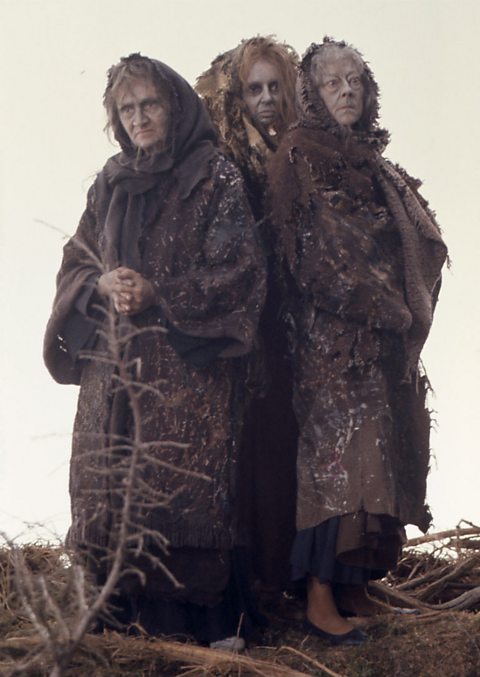The Witches in Macbeth

Although there is clearly more than one of them, the Witches may be seen as seem as a single character; they are often referred to as "The Weird Sisters".
Their predictions drive matters forward though they never actually suggest direct action. Rather, they plant ideas in Macbeth's mind and let his ambition do the rest. Many of their predictions are ambiguousSomething that could be interpreted in more than one way..
| How are the Witches like this? | Evidence | Analysis | |
| Supernatural | The Witches are clearly unlike any other characters in the play. Their physical appearance, their style of speech, their actions and their apparent ability to predict the future sets them apart from the humans they seek to control. | Round about the cauldron go; / In, the poisoned entrails throw. / Toad, that under cold stone / Days and nights hast thirty-one / Sweltered venom sleeping got, / Boil thou first i'th'charmĆØd pot. / Double, double, toil and trouble; / Fire burn, and cauldron bubble. (Act 4 Scene 1) | The Witches meet around one of the most well-known symbols of witchcraft - a cauldron. Into this they throw all manner of foul and evil objects ('poisoned entrails') and cast a spell. Although it is not clear what the spell is for, it is obvious they are up to no good. The Witches' chant is in a different rhythm to the way the other characters speak - this also suggests their supernatural nature. |
| Ambiguous | When the Witches make their predictions, they only say what will happen and not how it will happen. Macbeth falls into their trap and believes that he is safer than he actually is. | THIRD APPARITION: Be lion-mettled, proud, and take no care / Who chafes, who frets, or where conspirers are. / Great Birnam Wood to high Dunsinane hill / Shall come against him. MACBETH: That will never be. (Act 4 Scene 1) | The Witches have conjured up three ghostly visions that make ambiguous predictions. Macbeth is told that he need not fear anything ('take no care who chafes, who frets, or where conspirers are') until a forest of trees uproots itself and moves. As this seems to be a physical impossibility Macbeth instantly dismisses it ever happening ('That will never be'). The prediction will come true - but not quite in the way Macbeth expects. |
| Supernatural | |
|---|---|
| How are the Witches like this? | The Witches are clearly unlike any other characters in the play. Their physical appearance, their style of speech, their actions and their apparent ability to predict the future sets them apart from the humans they seek to control. |
| Evidence | Round about the cauldron go; / In, the poisoned entrails throw. / Toad, that under cold stone / Days and nights hast thirty-one / Sweltered venom sleeping got, / Boil thou first i'th'charmĆØd pot. / Double, double, toil and trouble; / Fire burn, and cauldron bubble. (Act 4 Scene 1) |
| Analysis | The Witches meet around one of the most well-known symbols of witchcraft - a cauldron. Into this they throw all manner of foul and evil objects ('poisoned entrails') and cast a spell. Although it is not clear what the spell is for, it is obvious they are up to no good. The Witches' chant is in a different rhythm to the way the other characters speak - this also suggests their supernatural nature. |
| Ambiguous | |
|---|---|
| How are the Witches like this? | When the Witches make their predictions, they only say what will happen and not how it will happen. Macbeth falls into their trap and believes that he is safer than he actually is. |
| Evidence | THIRD APPARITION: Be lion-mettled, proud, and take no care / Who chafes, who frets, or where conspirers are. / Great Birnam Wood to high Dunsinane hill / Shall come against him. MACBETH: That will never be. (Act 4 Scene 1) |
| Analysis | The Witches have conjured up three ghostly visions that make ambiguous predictions. Macbeth is told that he need not fear anything ('take no care who chafes, who frets, or where conspirers are') until a forest of trees uproots itself and moves. As this seems to be a physical impossibility Macbeth instantly dismisses it ever happening ('That will never be'). The prediction will come true - but not quite in the way Macbeth expects. |